Are you planning a trip to Joshua Tree National Park and wondering How To Get To Arch Rock? Rockscapes.net is here to guide you through this natural wonder, offering insights into its unique geological formations and the best ways to experience its beauty. We will provide a straightforward guide on finding Arch Rock, along with tips and information to enhance your visit, including exploring rock formations and enjoying the desert landscape.
1. What is Arch Rock and Why Visit It?
Arch Rock is a natural arch formation located in Joshua Tree National Park, California. It is a popular attraction for hikers and nature enthusiasts due to its unique geological structure and the stunning desert scenery surrounding it. According to the National Park Service, Arch Rock was formed over millions of years through erosion and weathering of the park’s granite rock formations.
Why should you visit Arch Rock?
- Unique Geological Formation: Arch Rock offers a fascinating example of natural rock formations shaped by erosion.
- Easy Hike: The trail to Arch Rock is relatively short and easy, making it accessible for most visitors.
- Photographic Opportunities: The arch provides a stunning backdrop for photos, especially during sunrise and sunset.
- Connection with Nature: Exploring Arch Rock allows you to immerse yourself in the serene beauty of Joshua Tree National Park.
2. Where is Arch Rock Located?
Arch Rock is located in the White Tank Campground area of Joshua Tree National Park. To find it, you’ll want to head towards the center of the park.
How do I get to Arch Rock?
- From the North: If you are coming from the north, drive south on Park Boulevard, then turn left onto Pinto Basin Road.
- From the South: If you are coming from the south, drive north on Pinto Basin Road.
- White Tank Campground: Look for signs directing you to the White Tank Campground. Turn into the campground.
3. What is the Arch Rock Trail Like?
The Arch Rock Trail is a short, easy hike that takes you to the arch. It’s perfect for families, novice hikers, and anyone looking for a quick and rewarding outdoor experience.
What can I expect on the Arch Rock Trail?
- Distance: The trail is approximately 1 mile round trip.
- Elevation Gain: The elevation gain is minimal, making it a relatively flat hike.
- Terrain: The trail is mostly sandy and rocky, with some areas requiring light scrambling over boulders.
- Scenery: Along the trail, you’ll be surrounded by Joshua trees, unique rock formations, and the vast desert landscape.
- Difficulty: Easy, suitable for all fitness levels.
- Hiking Time: About 20-40 minutes, depending on your pace and how long you spend exploring.
4. Step-by-Step Directions to Arch Rock
Navigating to Arch Rock is straightforward, ensuring you don’t miss this natural wonder.
Here are detailed directions to guide you:
- Park at Twin Tanks Parking Area: The parking area is very close to White Tank Campground.
- Find the Trailhead: Look for the trailhead signs. The trail is well-marked and easy to follow.
- Hike the Arch Rock Nature Trail: Follow the trail as it winds through the desert landscape. Enjoy the scenery and keep an eye out for interesting rock formations along the way.
- Arrive at Arch Rock: After a short walk, you’ll reach Arch Rock. Take your time to admire the arch, take photos, and explore the surrounding area.
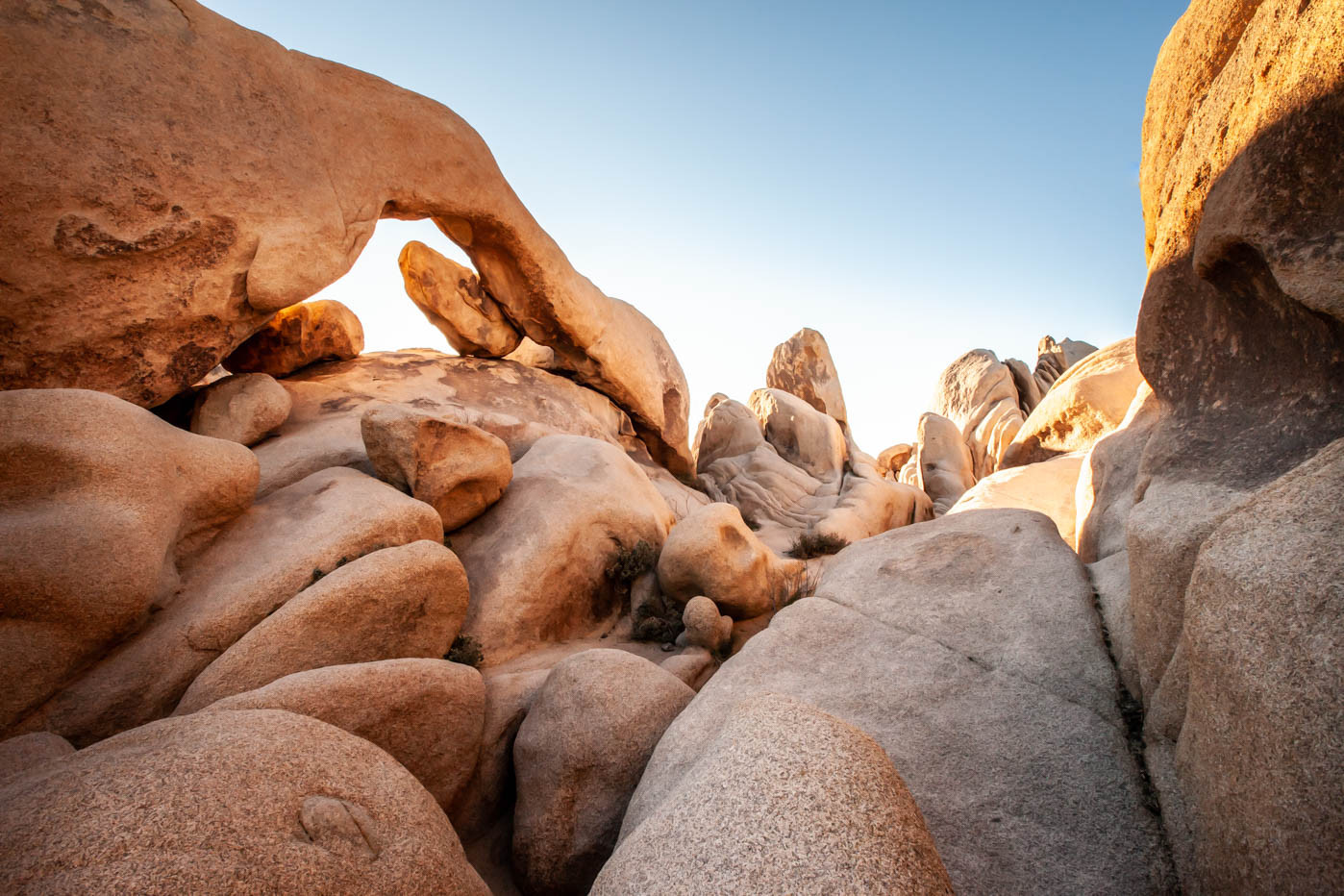 Arch Rock at Joshua Tree National Park with a clear blue sky
Arch Rock at Joshua Tree National Park with a clear blue sky
5. What Can You Do at Arch Rock?
Arch Rock offers various activities, making your visit memorable and enjoyable.
Activities to enjoy at Arch Rock:
- Hiking: Explore the Arch Rock Nature Trail and discover the surrounding desert landscape.
- Photography: Capture the beauty of Arch Rock and the unique rock formations. Early morning or late afternoon light is ideal for photography.
- Rock Climbing and Bouldering: The area around Arch Rock is a popular spot for bouldering.
- Picnicking: Enjoy a picnic amidst the stunning desert scenery. Remember to bring plenty of water and snacks.
- Stargazing: Joshua Tree National Park is known for its dark night skies, making it an excellent place for stargazing.
6. What Should You Bring on Your Hike?
Being prepared for your hike to Arch Rock will ensure a safe and enjoyable experience.
Essential items to bring:
- Water: Carry plenty of water, especially during the warmer months.
- Snacks: Pack energy-boosting snacks like trail mix, nuts, or energy bars.
- Sunscreen: Protect your skin from the harsh desert sun with a high SPF sunscreen.
- Hat and Sunglasses: Shield your face and eyes from the sun.
- Comfortable Shoes: Wear sturdy hiking shoes or boots with good traction.
- First-Aid Kit: Include essentials like bandages, antiseptic wipes, and pain relievers.
- Map and Compass/GPS: While the trail is well-marked, it’s always good to have a map and compass or GPS as a backup.
- Camera: Don’t forget your camera to capture the stunning scenery and unique rock formations.
7. What Are Some Tips for Visiting Arch Rock?
To make the most of your visit to Arch Rock, consider these helpful tips.
Tips for an enjoyable visit:
- Visit Early or Late in the Day: The temperatures are cooler, and the lighting is better for photography.
- Check the Weather Forecast: Be aware of the weather conditions and dress accordingly.
- Stay on the Trail: Help protect the fragile desert ecosystem by staying on marked trails.
- Leave No Trace: Pack out everything you pack in and dispose of waste properly.
- Be Aware of Wildlife: Joshua Tree National Park is home to various wildlife, including snakes and lizards. Be cautious and observe animals from a distance.
- Take Breaks: Rest and rehydrate as needed, especially during hot weather.
- Inform Someone of Your Plans: Let someone know your hiking plans, including your route and expected return time.
- Respect the Environment: Avoid disturbing plants, rocks, and other natural features.
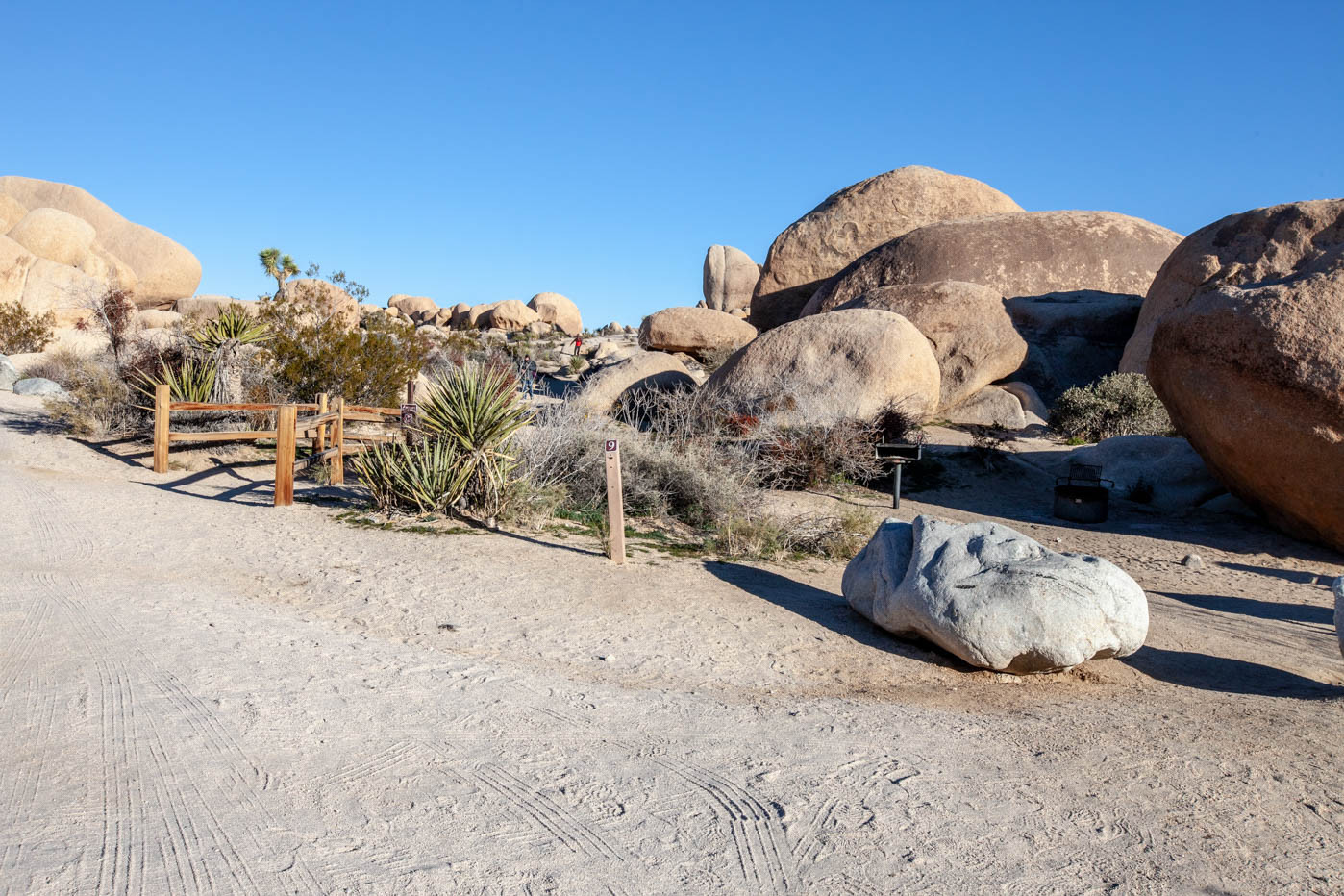 Entrance to the Arch Rock Nature Trail at White Tank Campground
Entrance to the Arch Rock Nature Trail at White Tank Campground
8. What Other Attractions Are Near Arch Rock?
Joshua Tree National Park is full of incredible sights and attractions.
Nearby attractions to explore:
- Heart Rock: A rock formation shaped like a heart, located a short distance from Arch Rock.
- Skull Rock: A unique rock formation resembling a skull, located along Park Boulevard.
- Barker Dam Nature Trail: An easy hike to a dam where you can often spot wildlife.
- Hidden Valley Nature Trail: A scenic loop trail through a valley surrounded by rock formations.
- Cholla Cactus Garden: A fascinating garden filled with thousands of cholla cacti.
- Keys View: A panoramic viewpoint offering stunning views of the Coachella Valley.
9. What is the History and Geology of Arch Rock?
Understanding the history and geology of Arch Rock adds depth to your visit.
Historical and geological facts:
- Formation: Arch Rock was formed over millions of years through the erosion of granite rock. Water and wind gradually wore away the softer rock, leaving the arch-shaped formation.
- Geological Significance: The granite rocks in Joshua Tree National Park are part of the Pinto Gneiss, which dates back 1.7 billion years.
- Early Inhabitants: The area around Arch Rock was inhabited by Native Americans for thousands of years, who used the natural resources for sustenance and shelter.
- Park Establishment: Joshua Tree National Park was established in 1936 as a national monument and later designated as a national park in 1994.
10. What are the Best Times to Visit Arch Rock?
Choosing the right time to visit Arch Rock can enhance your experience.
Best times to visit:
- Spring and Fall: These seasons offer mild temperatures and pleasant hiking conditions.
- Early Morning: Visit early in the morning to avoid crowds and enjoy cooler temperatures. The lighting is also ideal for photography.
- Late Afternoon: Another great time to visit is in the late afternoon, as the setting sun casts a warm glow on the landscape.
- Weekdays: If possible, visit during the weekdays to avoid the larger crowds that gather on weekends.
11. Where Can You Stay Near Arch Rock?
There are several lodging options available both inside and outside Joshua Tree National Park.
Accommodation options:
-
Camping in Joshua Tree National Park:
- White Tank Campground: Located near Arch Rock, this campground offers a convenient place to stay.
- Other Campgrounds: There are several other campgrounds in the park, including Jumbo Rocks, Ryan Campground, and Black Rock Campground.
-
Hotels and Motels in Nearby Towns:
- Joshua Tree: The town of Joshua Tree offers a variety of hotels, motels, and vacation rentals.
- Twentynine Palms: Located near the park’s east entrance, Twentynine Palms also has several lodging options.
- Yucca Valley: Another nearby town with hotels and vacation rentals.
-
Vacation Rentals: Consider renting a house or cabin in one of the nearby towns for a more comfortable and private stay.
12. How Can You Ensure Safety on the Trail?
Safety should be a top priority when hiking to Arch Rock.
Safety precautions:
- Stay Hydrated: Drink plenty of water before, during, and after your hike.
- Wear Appropriate Clothing: Dress in layers and wear moisture-wicking fabrics to stay comfortable.
- Protect Yourself from the Sun: Wear sunscreen, a hat, and sunglasses to protect yourself from the sun.
- Be Aware of the Weather: Check the weather forecast before you go and be prepared for changing conditions.
- Watch Your Step: The trail can be rocky and uneven, so watch your step and take your time.
- Avoid Hiking Alone: Hike with a friend or family member if possible.
- Carry a Communication Device: Bring a cell phone or satellite phone in case of emergencies.
- Know Your Limits: Don’t attempt a hike that is beyond your fitness level.
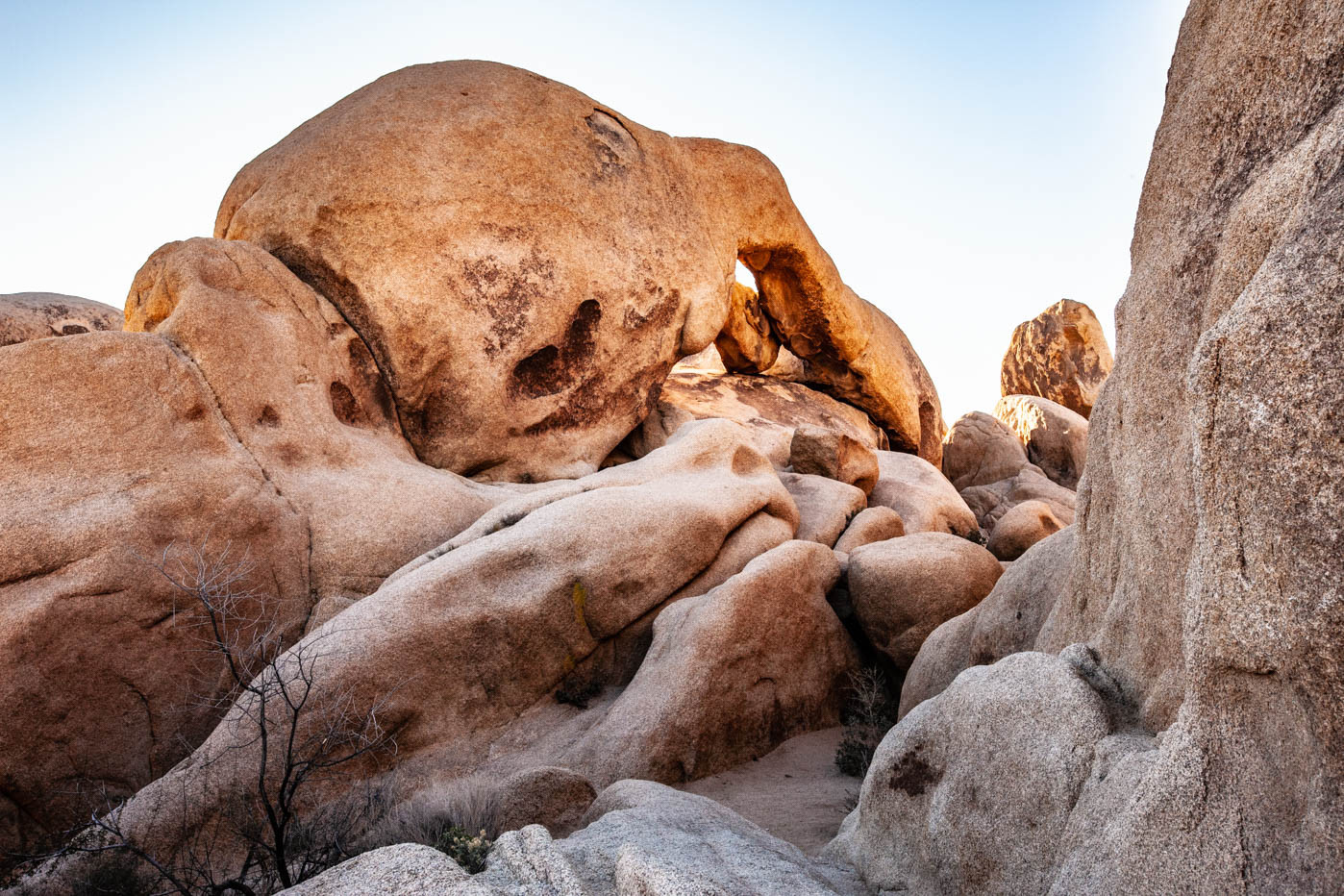 Arch Rock surrounded by desert landscape
Arch Rock surrounded by desert landscape
13. How Can You Respect the Environment While Visiting?
Preserving the natural beauty of Joshua Tree National Park is essential.
Environmental stewardship practices:
- Stay on Marked Trails: Avoid straying from the trail to protect vegetation and prevent erosion.
- Leave No Trace: Pack out everything you pack in, including trash and food scraps.
- Do Not Disturb Wildlife: Observe animals from a distance and do not feed them.
- Conserve Water: Use water sparingly and avoid wasting it.
- Respect Cultural Resources: Do not touch or remove any artifacts or historical objects.
- Minimize Campfire Impacts: Use established fire rings and keep fires small.
- Dispose of Waste Properly: Use designated trash receptacles and restrooms.
- Educate Others: Share your knowledge of environmental stewardship with other visitors.
14. How Does Arch Rock Fit into the Larger Joshua Tree Landscape?
Arch Rock is just one of the many geological wonders in Joshua Tree National Park.
Understanding the broader landscape:
- Rock Formations: Joshua Tree is famous for its unique rock formations, which were shaped by millions of years of erosion and weathering.
- Joshua Trees: The park is home to the iconic Joshua trees, which are a type of yucca plant that is unique to the Mojave Desert.
- Desert Ecosystem: The park is part of the Mojave Desert ecosystem, which is characterized by arid conditions, sparse vegetation, and diverse wildlife.
- Biodiversity: Despite its harsh environment, Joshua Tree National Park is home to a variety of plant and animal species, including desert tortoises, bighorn sheep, and various bird species.
- Geological History: The park’s geological history dates back billions of years, with evidence of ancient volcanic activity, tectonic uplift, and erosion.
15. What are the Photography Tips for Capturing Arch Rock?
Arch Rock offers fantastic opportunities for photographers.
Tips for capturing stunning photos:
- Golden Hour: Shoot during the golden hour (the hour after sunrise and the hour before sunset) for warm, soft light.
- Composition: Experiment with different compositions to find the most visually appealing angle.
- Leading Lines: Use natural lines in the landscape to lead the viewer’s eye to Arch Rock.
- Foreground Interest: Include interesting foreground elements, such as rocks or plants, to add depth to your photos.
- Wide-Angle Lens: Use a wide-angle lens to capture the entire arch and its surroundings.
- Tripod: Use a tripod to keep your camera steady, especially in low light conditions.
- Filters: Use a polarizing filter to reduce glare and enhance colors.
- Night Photography: Try shooting Arch Rock at night to capture the stars and Milky Way.
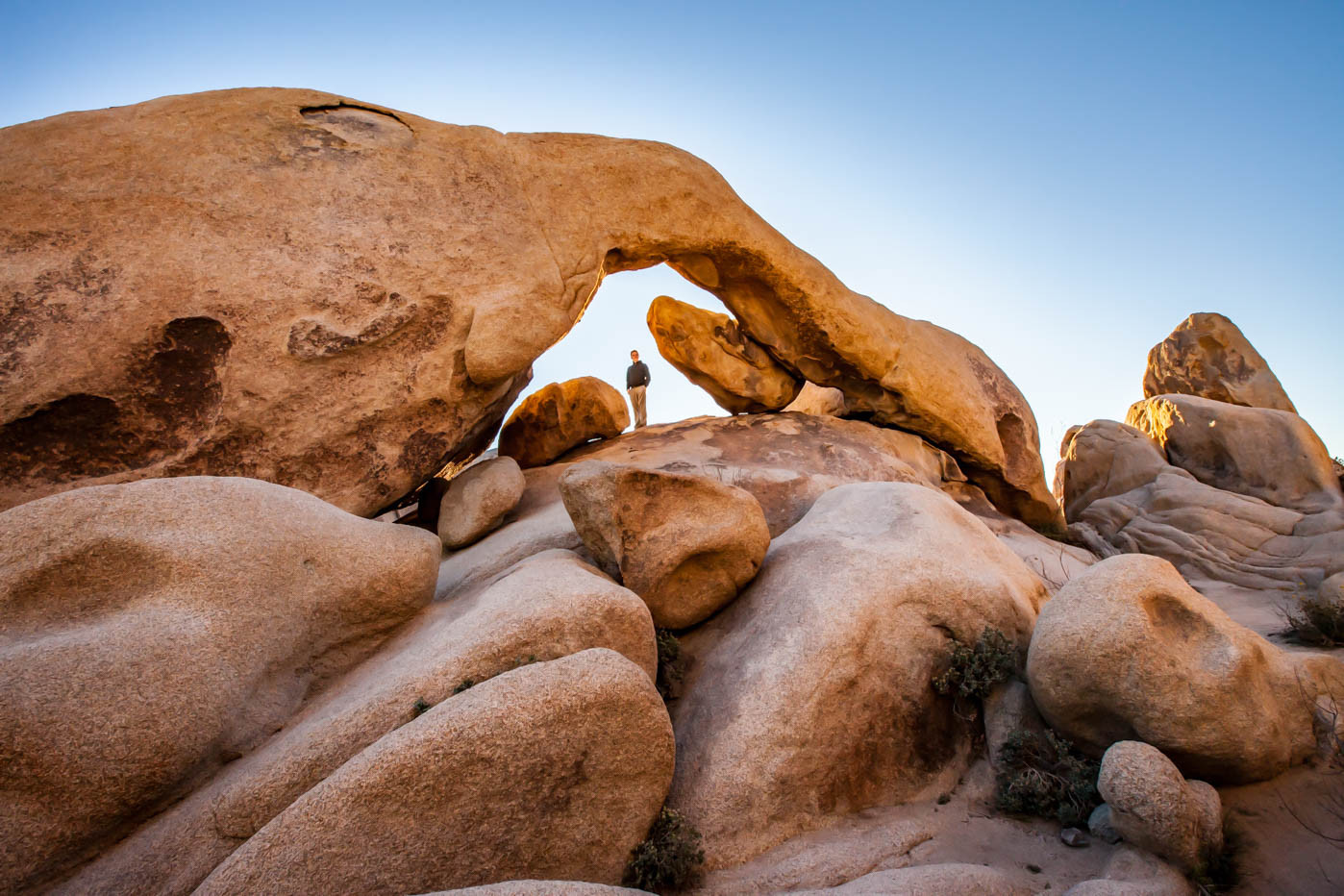 A person walking under Arch Rock at Joshua Tree National Park
A person walking under Arch Rock at Joshua Tree National Park
16. How Can You Extend Your Trip in Joshua Tree?
Joshua Tree National Park has so much to offer.
Ideas for extending your trip:
- Explore More Trails: Hike some of the park’s other trails, such as the Hidden Valley Nature Trail, Barker Dam Nature Trail, or Ryan Mountain Trail.
- Rock Climbing and Bouldering: Try rock climbing or bouldering in areas like Hidden Valley or Intersection Rock.
- Visit the Cholla Cactus Garden: Take a walk through the Cholla Cactus Garden and marvel at the thousands of cholla cacti.
- Drive to Keys View: Drive to Keys View for panoramic views of the Coachella Valley.
- Stargazing: Spend an evening stargazing in one of the park’s dark sky locations.
- Visit the Joshua Tree National Park Visitor Center: Learn more about the park’s history, geology, and ecology at the visitor center.
- Take a Ranger-Led Program: Participate in a ranger-led program to learn more about the park’s natural and cultural resources.
17. What are the Best Hikes Near Arch Rock for All Skill Levels?
Joshua Tree provides hikes for all skill levels.
Recommended hikes near Arch Rock:
-
Easy:
- Arch Rock Nature Trail: (1 mile round trip) A short, easy hike to Arch Rock, suitable for all fitness levels.
- Barker Dam Nature Trail: (1.1 miles round trip) A relatively flat trail to a dam where you can often spot wildlife.
- Hidden Valley Nature Trail: (1 mile loop) An easy loop trail through a valley surrounded by rock formations.
-
Moderate:
- Ryan Mountain Trail: (3 miles round trip) A moderate hike to the summit of Ryan Mountain, offering panoramic views of the park.
- Lost Horse Mine Trail: (4 miles round trip) A moderate hike to the historic Lost Horse Mine, with remnants of mining operations.
-
Difficult:
- Mount San Jacinto: (11 miles round trip) A challenging hike to the summit of Mount San Jacinto, offering stunning views of the surrounding landscape.
- California Riding and Hiking Trail: (37 miles) Experience varied terrain.
18. How Do You Get Around Joshua Tree National Park?
Knowing your transport options is essential.
Transportation options:
- Car: The most convenient way to get around Joshua Tree National Park is by car. The park has paved roads that provide access to most of the main attractions.
- Bicycle: Bicycling is a great way to explore the park, especially on the paved roads.
- Hiking: Hiking is the best way to experience the park’s backcountry and see the unique rock formations and vegetation up close.
- Shuttle: During peak season, there may be shuttle services available to transport visitors to popular destinations within the park.
- Ridesharing: Ridesharing services like Uber and Lyft may be available in the towns near the park, but service within the park is limited.
19. What Is the Weather Like in Joshua Tree National Park?
The weather in Joshua Tree can be extreme.
Weather conditions:
- Spring: Spring is a popular time to visit Joshua Tree, with mild temperatures and blooming wildflowers.
- Summer: Summers are hot, with temperatures often exceeding 100°F (38°C).
- Fall: Fall is another pleasant time to visit, with cooler temperatures and clear skies.
- Winter: Winters are cool, with daytime temperatures averaging in the 50s°F (10-15°C).
- Temperature Fluctuations: Temperatures can fluctuate dramatically between day and night, so be prepared for both warm and cold conditions.
- Sun Exposure: The desert sun is intense, so wear sunscreen, a hat, and sunglasses.
- Flash Floods: Be aware of the risk of flash floods, especially during the monsoon season (July-September).
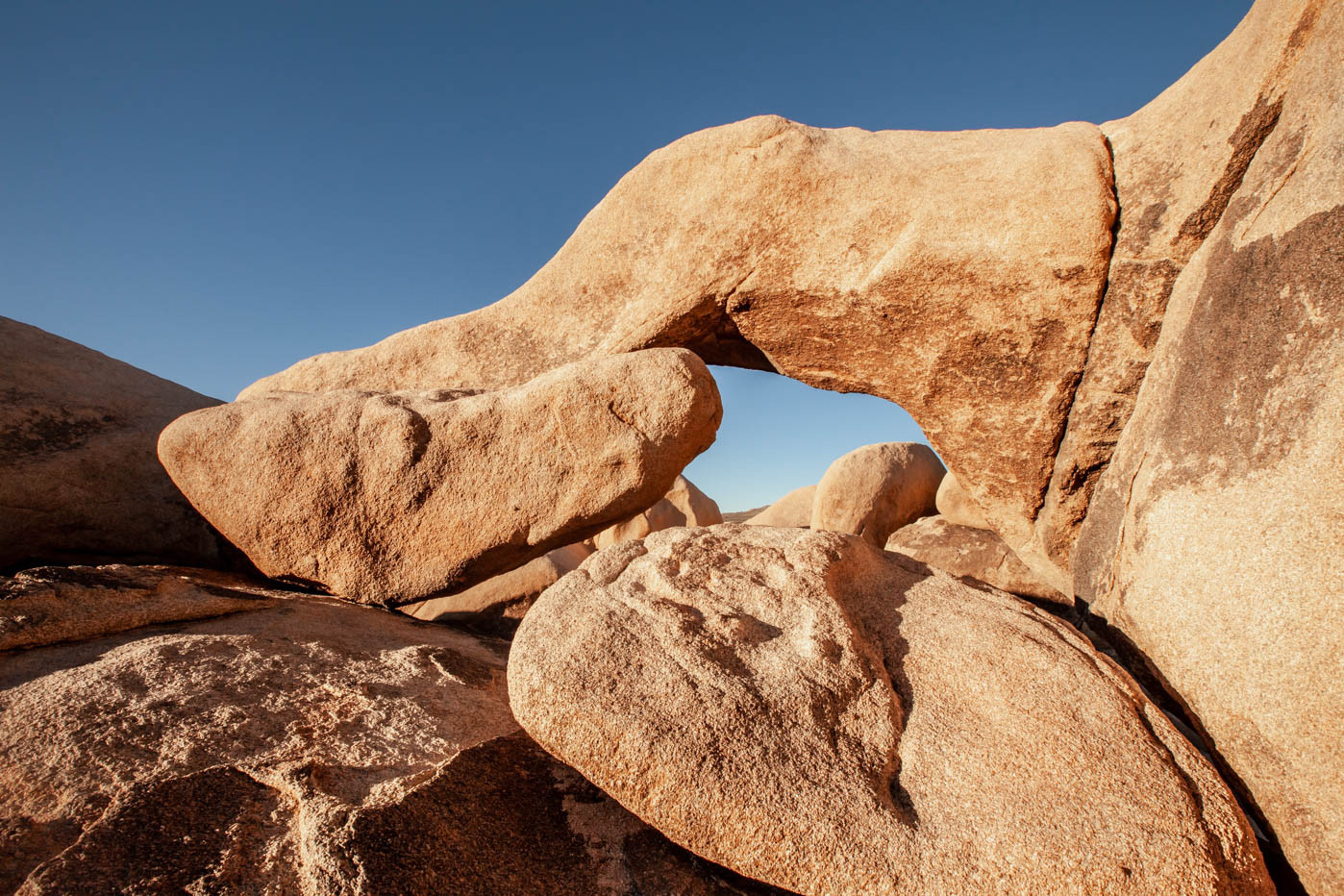 The back side of Arch Rock with desert vegetation
The back side of Arch Rock with desert vegetation
20. How Can Rockscapes.net Enhance Your Visit to Joshua Tree?
Rockscapes.net can provide valuable information and resources to enhance your visit to Joshua Tree National Park.
Benefits of using Rockscapes.net:
- Design Inspiration: Explore various design ideas showcasing the creative possibilities of natural stone.
- Stone Varieties: Gain access to detailed information about different types of natural stones, including their characteristics, textures, and ideal applications.
- Expert Advice: Benefit from expert advice on selecting the right stones for your project, ensuring both aesthetic appeal and structural integrity.
- DIY Guides: Follow step-by-step DIY guides to create stunning stone features in your landscape.
- Supplier Network: Connect with a network of trusted stone suppliers in the USA, ensuring you source high-quality materials.
- Project Planning Tools: Utilize project planning tools to estimate material quantities and costs, helping you stay within budget.
- Maintenance Tips: Learn essential maintenance tips to keep your stone features looking beautiful for years to come.
- Community Forum: Engage with a community of fellow stone enthusiasts to share ideas, ask questions, and get inspired.
Planning your visit to Arch Rock in Joshua Tree National Park is an exciting endeavor, and with the right preparation, you’re sure to have an unforgettable experience. Remember to stay hydrated, wear appropriate clothing, and be mindful of the fragile desert environment. Whether you’re an avid hiker, a photography enthusiast, or simply seeking a tranquil escape into nature, Arch Rock offers something for everyone.
Ready to explore the captivating world of rockscapes and elevate your outdoor spaces? Visit rockscapes.net today for a wealth of design inspiration, expert advice, and premium natural stone solutions. Let’s create breathtaking landscapes together!
FAQ: Your Questions About Visiting Arch Rock Answered
Here are some frequently asked questions about visiting Arch Rock in Joshua Tree National Park:
- Is Arch Rock accessible to people with disabilities?
While the main trail to Arch Rock is relatively flat, some areas may be challenging for those with mobility issues due to rocky terrain. - Are pets allowed on the Arch Rock Trail?
Pets are generally not allowed on trails in Joshua Tree National Park, including the Arch Rock Trail. - Is there a fee to visit Arch Rock?
Yes, there is an entrance fee to Joshua Tree National Park. You can purchase a pass at the park entrance or online. - How crowded does the Arch Rock Trail get?
The Arch Rock Trail can get crowded, especially during peak season. Visit early or late in the day to avoid the crowds. - Are there restrooms near Arch Rock?
Restrooms are available at the White Tank Campground, which is located near the trailhead for Arch Rock. - Can I climb on Arch Rock?
While it may be tempting to climb on Arch Rock, it is important to respect the natural formation and avoid climbing on it. - Are there guided tours available to Arch Rock?
Ranger-led programs and guided tours may be available, check the park’s website for schedule. - Is there cell phone service near Arch Rock?
Cell phone service in Joshua Tree National Park can be unreliable, especially in remote areas. - Can I see Arch Rock at night?
Yes, Arch Rock can be visited at night. Stargazing at Arch Rock can be a magical experience. - What should I do if I encounter wildlife on the trail?
If you encounter wildlife on the trail, observe the animals from a distance and do not approach or feed them.